Design interfaces with the Control nodes¶
Computer displays, mobile phones, and TV screens come in all shapes and sizes. To ship a game, you'll need to support different screen ratios and resolutions. It can be hard to build responsive interfaces that adapt to all platforms. Thankfully, Godot comes with robust tools to design and manage a responsive User Interface.
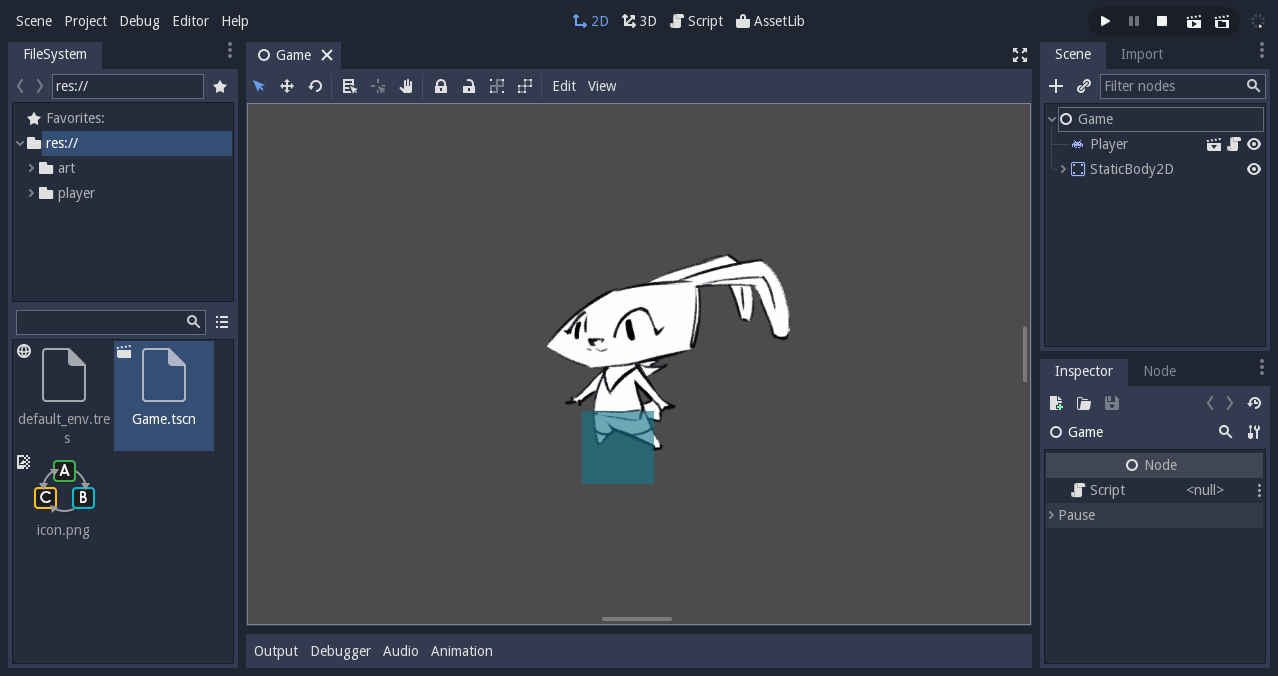
Godot's editor is made with the engine's UI framework¶
This guide will get you started with UI design. You will learn:
The five most useful control nodes to build your games' interface
How to work with the anchor of UI elements
How to efficiently place and arrange your user interface using containers
The five most common containers (you can learn more about containers in the GUI Containers documentation page).
To learn how to control the interface and connect it to other scripts, read Build your first game UI in Godot.
To design your UI, you'll use the Control nodes. These are the nodes with green icons in the editor. There are dozens of them, for creating anything from life bars to complex applications. Godot's editor itself is built using Control nodes.
Control nodes have unique properties that allow them to work well with one another. Other visual nodes, like Node2D and Sprite don't have these capabilities. So to make your life easier use Control nodes wherever possible when building your UIs.
All control nodes share the same main properties:
Anchor
Bounding rectangle
Focus and focus neighbor
Size flags
Margin
The optional UI theme
Once you understand the basics of the Control node, it will take you less time to learn all the nodes that derive from it.
The 5 most common UI elements¶
Godot ships with dozens of Control nodes. A lot of them are here to help you build editor plugins and applications.
For most games, you'll only need five types of UI elements, and a few Containers. These five Control nodes are:
Label: for displaying text
TextureRect: used mostly for backgrounds, or everything that should be a static image
TextureProgress: for lifebars, loading bars, horizontal, vertical or radial
NinePatchRect: for scalable panels
TextureButton: to create buttons

The 5 most common Control nodes for UI design¶
TextureRect¶
TextureRect displays a texture or image inside a UI. It seems similar to the Sprite node, but it offers multiple scaling modes. Set the Stretch Mode property to change its behavior:
Scale On Expand (compat)scales the texture to fit the node's bounding rectangle, only ifexpandproperty istrue; otherwise, it behaves likeKeepmode. Default mode for backwards compatibility.Scalescales the texture to fit the node's bounding rectangle.Tilemakes the texture repeat, but it won't scale.KeepandKeep Centeredforce the texture to remain at its original size, in the top left corner or the center of the frame respectively.Keep AspectandKeep Aspect Centeredscales the texture but force it to remain its original aspect ratio, in the top left corner or the center of the frame respectively.Keep Aspect Coveredworks just likeKeep Aspect Centeredbut the shorter side fits the bounding rectangle and the other one clips to the node's limits.
As with Sprite nodes, you can modulate the TextureRect's color. Click
the Modulate property and use the color picker.
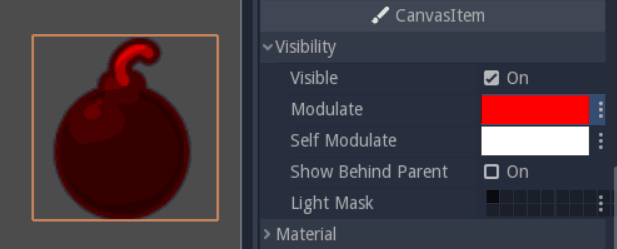
TextureRect modulated with a red color¶
TextureButton¶
TextureButton is like TextureRect, except it has 6 texture slots: one for each of the button's states. Most of the time, you'll use the Normal, Pressed, and Hover textures. Focused is useful if your interface listens to the keyboard's input. The sixth image slot, the Click Mask, lets you define the clickable area using a 1-bit, pure black and white image.
In the Base Button section, you'll find a few checkboxes that change how
the button behaves. When Toggle Mode is on, the button will toggle
between active and normal states when you press it. Disabled makes it
disabled by default, in which case it will use the Disabled texture.
TextureButton shares a few properties with the texture frame: it has a
modulate property, to change its color, and Resize and Stretch modes to
change its scale behavior.
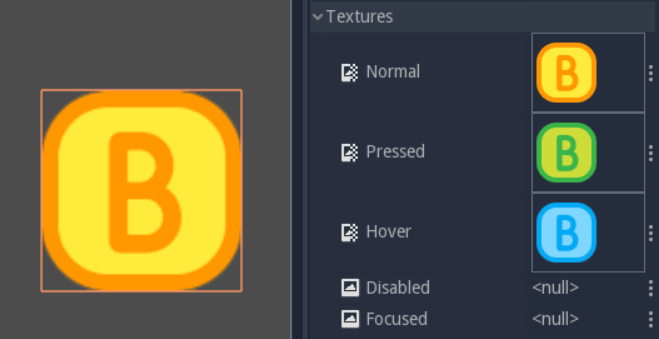
TextureButton and its 5 texture slots¶
TextureProgress¶
TextureProgress layers up to 3 sprites to create a progress bar. The Under and Over textures sandwich the Progress one, which displays the bar's value.
The Mode property controls the direction in which the bar grows:
horizontally, vertically, or radially. If you set it to radial, the
Initial Angle and Fill Degrees properties let you limit the range of the
gauge.
To animate the bar, you'll want to look at the Range section. Set the
Min and Max properties to define the range of the gauge. For instance,
to represent a character's life, you'll want to set Min to 0, and Max to
the character's maximum life. Change the Value property to update the
bar. If you leave the Min and Max values to the default of 0 and 100,
and set the Value property to 40, 40% of the Progress texture will show
up, and 60% of it will stay hidden.

TextureProgress bar, two thirds filled¶
Label¶
Label prints text to the screen. You'll find all its properties in
the Label section, in the Inspector. Write the text in the Text
property, and check Autowrap if you want it to respect the textbox's
size. If Autowrap is off, you won't be able to scale the node. You can
align the text horizontally and vertically with Align and Valign,
respectively.
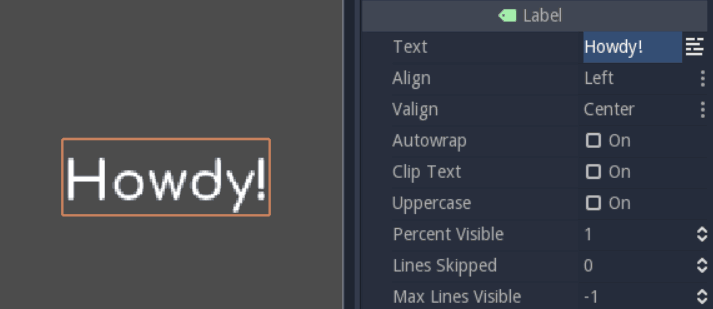
Picture of a Label¶
There are two workflows to build responsive UIs¶
There are two workflows to build scalable and flexible interfaces in Godot:
Place UI elements precisely with anchors: Use the Layout menu to place and resize a UI element relative to its parent.
Arrange control nodes automatically with containers: Use container nodes to automatically scale and place UI elements.
The two approaches are not always compatible. Because a container controls its children, you cannot use the layout menu on them. Each container has a specific effect, so you may need to nest several of them to get a working interface. With the layout approach you work from the bottom up, on the children. As you don't insert extra containers in the scene it can make for cleaner hierarchies, but it's harder to arrange items in a row, column, grid, etc.
As you create UIs for your games and tools, you'll develop a sense for what fits best in each situation.
Place UI elements precisely with anchors¶
Control nodes have a position and size, but they also have anchors and margins. Anchors define the origin, or the reference point, for the Left, Top, Right and Bottom edges of the node. Change any of the 4 anchors to change the reference point of the margins.
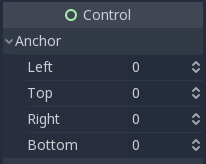
The anchor property¶
How to change the anchor¶
Like any properties, you can edit the 4 anchor points in the Inspector, but this is not the most convenient way. When you select a control node, the layout menu appears above the viewport, in the toolbar. It gives you a list of icons to set all 4 anchors with a single click, instead of using the inspector's 4 properties. The layout menu will only show up when you select a control node.

The layout menu in the viewport¶
Anchors are relative to the parent container¶
Each anchor is a value between 0 and 1. For the left and top anchors, a value of 0 means that without any margin, the node's edges will align with the left and top edges of its parent. For the right and bottom edges, a value of 1 means they'll align with the parent container's right and bottom edges. On the other hand, margins represent a distance to the anchor position in pixels, while anchors are relative to the parent container's size.
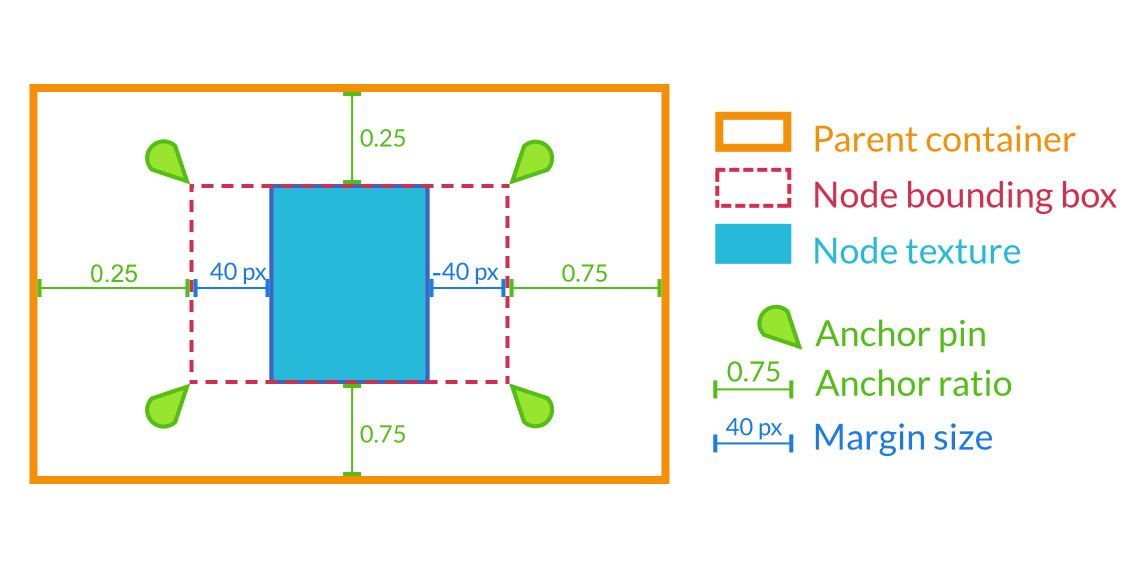
Margins are relative to the anchor position, which is relative to the anchors. In practice, you'll often let the container update margins for you¶
Margins change with the anchor¶
Margins update automatically when you move or resize a control node. They represent the distance from the control node's edges to its anchor, which is relative to the parent control node or container. That's why your control nodes should always be inside a container, as we'll see in a moment. If there's no parent, the margins will be relative to the node's own bounding Rectangle, set in the Rect section, in the inspector.

Margins on a CenterContainer set to the "Full Rect" anchor¶
Try to change the anchors or nest your Control nodes inside Containers: the margins will update. You'll rarely need to edit the margins manually. Always try to find a container to help you first; Godot comes with nodes to solve all the common cases for you. Need to add space between a lifebar and the border of the screen? Use the MarginContainer. Want to build a vertical menu? Use the VBoxContainer. More on these below.
Use size tags to change how UI elements fill the available space¶
Every control node has Size Flags. They tell containers how the UI elements should scale. If you add the "Fill" flag to the Horizontal or Vertical property, the node's bounding box will take all the space it can, but it'll respect its siblings and retain its size. If there are 3 TextureRect nodes in an HBoxContainer, with the "Fill" flags on both axes, they'll each take up to a third of the available space, but no more. The container will take over the node and resize it automatically.
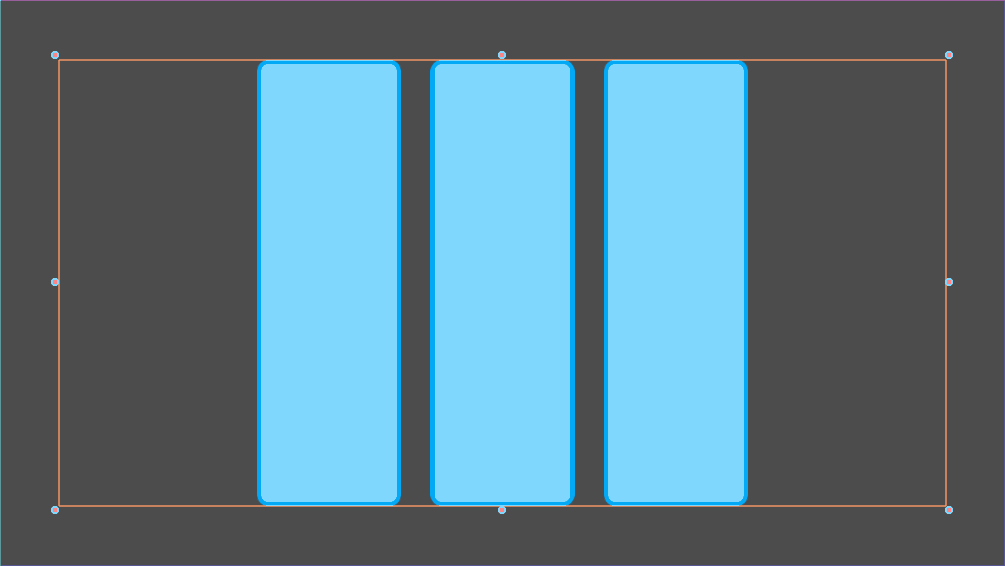
3 UI elements in an HBoxContainer, they align horizontally¶
The "Expand" flag lets the UI element take all the space it can, and push against its siblings. Its bounding rectangle will grow against the edges of its parent, or until it's blocked by another UI node.
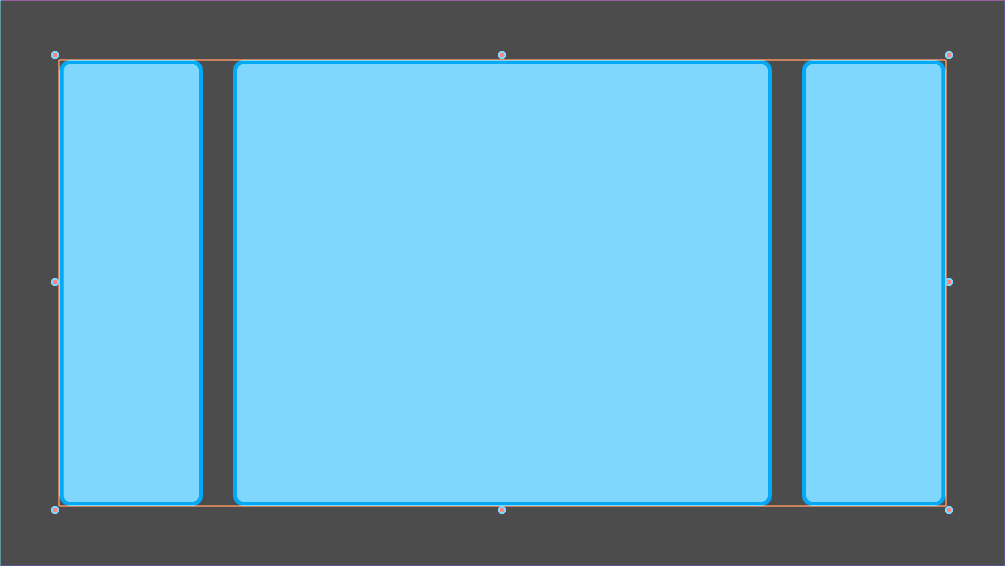
The same example as above, but the center node has the "Expand" size flag¶
You'll need some practice to understand the size tags, as their effect can change quite a bit depending on how you set up your interface.
Arrange control nodes automatically with containers¶
Containers automatically arrange all children Control nodes including other containers in rows, columns, and more. Use them to add padding around your interface or center nodes in their bounding rectangles. All built-in containers update in the editor, so you can see the effect instantly.
Containers have a few special properties to control how they arrange UI elements. To change them, navigate down to the Custom Constants section in the Inspector.
The 5 most useful containers¶
If you build tools, you might need all of the containers. But for most games, a handful will be enough:
MarginContainer, to add margins around parts of the UI
CenterContainer, to center its children in its bounding box
VboxContainer and HboxContainer, to arrange UI elements in rows or columns
GridContainer, to arrange Controls nodes in a grid-like pattern
CenterContainer centers all its children inside of its bounding rectangle. It's one you typically use for title screens, if you want the options to stay in the center of the viewport. As it centers everything, you'll often want a single container nested inside it. If you use textures and buttons instead, they'll stack up.

CenterContainer in action. The life bar centers inside its parent container.¶
The MarginContainer adds a margin on any side of the child nodes. Add a MarginContainer that encompasses the entire viewport to add a separation between the edge of the window and the UI. You can set a margin on the top, left, right, or bottom side of the container. No need to tick the checkbox: click the corresponding value box and type any number. It will activate automatically.

The MarginContainer adds a 40px margin around the Game User Interface¶
There are two BoxContainers: VBoxContainer and HBoxContainer. You cannot add the BoxContainer node itself, as it is a helper class, but you can use vertical and horizontal box containers. They arrange nodes either in rows or columns. Use them to line up items in a shop, or to build complex grids with rows and columns of different sizes, as you can nest them to your heart's content.

The HBoxContainer horizontally aligns UI elements¶
VBoxContainer automatically arranges its children into a column. It puts
them one after the other. If you use the separation parameter, it will
leave a gap between its children. HBoxContainer arranges UI elements in
a row. It's similar to the VBoxContainer, with an extra add_spacer
method to add a spacer control node before its first child or after its
last child, from a script.
The GridContainer lets you arrange UI elements in a grid-like pattern. You can only control the number of columns it has, and it will set the number of rows by itself, based on its children's count. If you have nine children and three columns, you will have 9÷3 = 3 rows. Add three more children and you'll have four rows. In other words, it will create new rows as you add more textures and buttons. Like the box containers, it has two properties to set the vertical and horizontal separation between the rows and columns respectively.
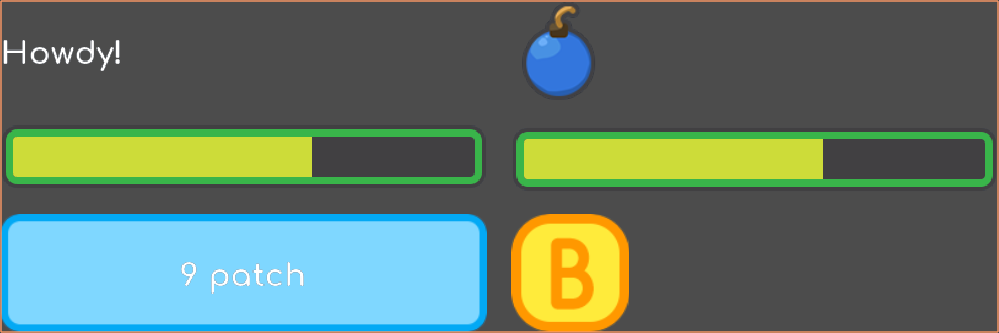
A GridContainer with 2 columns. It sizes each column automatically.¶
Godot's UI system is complex, and has a lot more to offer. To learn how to design more advanced interfaces, head to the GUI section of the docs.
